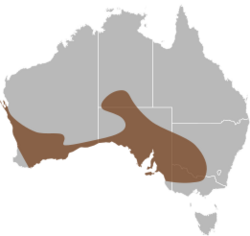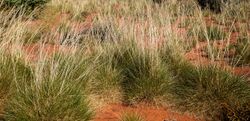Biology:Marble-faced delma
| Marble-faced delma | |
|---|---|

| |
| Scientific classification | |
| Domain: | Eukaryota |
| Kingdom: | Animalia |
| Phylum: | Chordata |
| Class: | Reptilia |
| Order: | Squamata |
| Family: | Pygopodidae |
| Genus: | Delma |
| Species: | D. australis
|
| Binomial name | |
| Delma australis Kluge, 1974
| |

| |
The Delma australis is often known as the southern legless lizard, or the marble-faced delma.[2] This terrestrial lizard falls into the category of slender Pygopodidae, a legless lizard.[2] There are 21 known species in the Pygopdidae family in Australia.[3] Marble-faced delmas are endemic to Australia.[citation needed] Delma australis was first described by Kluge in 1974.[3]
Description
D. australis is a brown to reddish brown colour with a greyish undersurface and greyish lips.[2] Their common name, marble-faced delma, comes from their grey-marble appearance. Distinctive features include ventral black bars on the top and sides of head with a short and rounded snout, and a tail twice the length of their body.[2] Geographical variation have been observed in marble-faced delma populations, the intensity of head patterning and head form can vary between populations in different areas.[3] There has been suggestions that there are a number of sub-species of D. australis, variation was discovered in Western Australia but further sampling is needed to determine if these differences were taxonomically significant.[3]
Ecology
Marble-faced delmas are classified as diurnal, however, have been observed in active states at night or around dawn and dusk.[2] They are often found in leaf litter, under rocks or in spinifex.[2] Classified as terrestrial, but can successfully climb hummock grass and branches of small shrubs.[2]
Distribution
Marble-faced delmas are widely distributed across southern Australia.[3] They are found to inhabit semi-arid to arid areas in southern Western Australia, most of South Australia, southern Northern Territory, north-west Victoria, and south-west New South Wales.[2] They are terrestrial, or land dwelling, species that are commonly found in spinifex grass.[2]
Distribution in New South Wales
Marble-faced delma populations are known to be in the Broken Hill Complex Interim Biogeographic Regionalisation of Australia Region, in some of the sub-regions of the Cobar Peneplain Interim Biogeographic Regionalisation of Australia Region, and in sub-regions of the Murray Darling Depression Interim Biogeographic Regionalisation of Australia Region.[4][5][6] In these areas the species in known to be within different vegetation formation and classes, including the Stony Desert Mulga Shrublands which is an Acacia sub-formation, Dune Mallee Woodlands which is a shrubby sub-formation, and Sand Plain Mallee Woodlands.[4][5][6] These areas are arid to semi-arid warm zones.[4]
Reproduction
Marble-faced delmas reproduce sexually and are oviparous (egg layers), with a clutch size of 2.[7] The eggs hatch after approximately 70 days.[2] They are precocial, meaning they are hatched in an advanced state where they are able to feed themselves and independently move.[citation needed]
Diet
Considered insectivores, they actively hunt for their food which primarily consists of insects and spiders.[8]
Conservation
The conservation status of marble-faced delmas in New South Wales is endangered, their conservation status is not listed in the Commonwealth.[2] Degradation of their habitat and losses in their population can be attributed to land use for agricultural purposes.[9] Over-grazing by livestock and feral species within their habitat affects the density and structure of spinifex.[9] Weed invasion and degradation of soil structure within the Mallee-spinifex habitat has also led to habitat loss for the Marble-faced delma populations.[9]
Threats
Threats of the marble-faced delma include: habitat clearance; an increase in fire frequencies reducing the amount of ground cover; predation; loss of leaf litter; heavy grazing and habitat trampling by stock, feral goats, rabbits and pigs.[2]
Predation
Predation is not a major threat, although it is likely foxes are a predator of the marble-faced delma.[2]
References
- ↑ Cowan, M.; Ellis, R.; How, R. (2017). "Delma australis". IUCN Red List of Threatened Species 2017: e.T102830336A102830353. doi:10.2305/IUCN.UK.2017-3.RLTS.T102830336A102830353.en. https://www.iucnredlist.org/species/102830336/102830353. Retrieved 18 November 2021.
- ↑ 2.00 2.01 2.02 2.03 2.04 2.05 2.06 2.07 2.08 2.09 2.10 2.11 2.12 "Marble-faced Delma - profile | NSW Environment, Energy and Science". https://www.environment.nsw.gov.au/threatenedspeciesapp/profile.aspx?id=10210.
- ↑ 3.0 3.1 3.2 3.3 3.4 Maryan, Brad; Brennan, Ian G.; Adams, Mark; Aplin, Ken P. (2015-04-10). "Molecular and morphological assessment of Delma australis Kluge (Squamata: Pygopodidae), with a description of a new species from the biodiversity 'hotspot' of southwestern Western Australia". Zootaxa 3946 (3): 301–330. doi:10.11646/zootaxa.3946.3.1. PMID 25947694. http://biotaxa.org/Zootaxa/article/view/zootaxa.3946.3.1.
- ↑ 4.0 4.1 4.2 "Marble-faced Delma - Broken Hill Complex: Distribution and vegetation associations | NSW Environment, Energy and Science". https://www.environment.nsw.gov.au/threatenedspeciesapp/profileData.aspx?id=10210&cmaName=Broken+Hill+Complex.
- ↑ 5.0 5.1 "Marble-faced Delma - Cobar Peneplain: Distribution and vegetation associations | NSW Environment, Energy and Science". https://www.environment.nsw.gov.au/threatenedspeciesapp/profileData.aspx?id=10210&cmaName=Cobar+Peneplain.
- ↑ 6.0 6.1 "Marble-faced Delma - Murray Darling Depression: Distribution and vegetation associations | NSW Environment, Energy and Science". https://www.environment.nsw.gov.au/threatenedspeciesapp/profileData.aspx?id=10210&cmaName=Murray+Darling+Depression.
- ↑ "Marble-faced Delma | Grasslands". https://grasslands.ecolinc.vic.edu.au/fieldguide/fauna/marble-faced-delma#details.
- ↑ Verdon, Simon J.; Watson, Simon J.; Nimmo, Dale G.; Clarke, Michael F. (2020-05-22). "Are all fauna associated with the same structural features of the foundation species Triodia scariosa?" (in en). Austral Ecology 45 (6): 773–787. doi:10.1111/aec.12894. https://onlinelibrary.wiley.com/doi/10.1111/aec.12894.
- ↑ 9.0 9.1 9.2 NSW Scientific Committee. "Marble-faced delma (Delma australis) - endangered species listing" (in en). http://www.environment.nsw.gov.au/topics/animals-and-plants/threatened-species/nsw-threatened-species-scientific-committee/determinations/final-determinations/2000-2003/marble-faced-delma-delma-australis-endangered-species-listing.
Wikidata ☰ Q5252982 entry
 |




